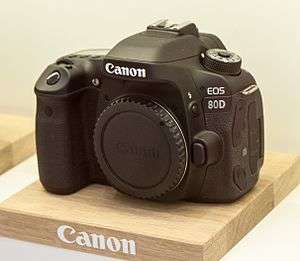Canon EOS 80D
The Canon EOS 80D is a digital single-lens reflex camera announced by Canon on February 18, 2016.[4][5] It has a body-only MSRP of US$1199, which is the same as the Canon EOS 70D, which it replaces. The camera can be purchased as a body-only, as kit with the 18-55mm IS STM lens at US$1,049, with the new 18-135mm IS USM lens at US$1,799 or with the EF-S 18-200mm IS at US$1,899.
 | |
| Overview | |
|---|---|
| Type | Digital single-lens reflex camera |
| Lens | |
| Lens | Interchangeable (EF / EF-S) |
| Sensor/medium | |
| Image sensor type | CMOS |
| Image sensor size | 22.3 × 14.9 mm (APS-C format) |
| Maximum resolution | 6000 × 4000 pixels (3.7 μm pixel size) (approx. 24.2 effective megapixels)[1] |
| ASA/ISO range | 100 – 16000 in 1/3 stop increments (expandable up to H: 25600) |
| Storage | SD/SDHC/SDXC card (UHS-I bus supported) |
| Focusing | |
| Focus modes | One-Shot, AI Focus, AI Servo, Live View (FlexiZone - Multi, FlexiZone - Single, Face detection, Movie Servo) |
| Focus areas | 45 cross-type AF points |
| Focus bracketing | N/A |
| Exposure/metering | |
| Exposure modes | Scene Intelligent Auto, Flash Off, Creative Auto, Special Scene (Portrait, Landscape, Close-up, Sports, Night Portrait, Handheld Night Scene, HDR Backlight Control), Creative Filters, Program AE, Shutter priority AE, Aperture priority AE, Manual exposure, Bulb exposure, Custom (2x), Movie |
| Exposure metering | TTL, full aperture, 63 zones sensor with 7560 pixels RGB + IR sensor |
| Metering modes | Evaluative, Partial, Spot, Centre-weighted Average |
| Flash | |
| Flash | E-TTL II auto-pop-up built-in / External |
| Flash bracketing | N/A |
| Shutter | |
| Shutter | Electronic focal-plane |
| Shutter speed range | 1/8000 sec. – 30 sec., Bulb; X-sync at 1/250 sec. |
| Continuous shooting | Up to 7.0 fps |
| Viewfinder | |
| Viewfinder | Optical pentaprism with 100% coverage and 0.95x magnification / LiveView LCD |
| Image processing | |
| Image processor | DIGIC 6 |
| Custom WB | Auto, Daylight, Shade, Cloudy, Tungsten, White Fluorescent, Flash, Kelvin (2500 K – 10000 K in 100 K steps) |
| WB bracketing | Yes |
| General | |
| Rear LCD monitor | 3.0" (7.7 cm) Clear View II colour TFT vari-angle LCD touchscreen with 1,040,000 dots |
| Battery | Li-Ion LP-E6N rechargeable (1800 mAh); 960 shots (CIPA rating) |
| Optional battery packs | BG-E14 grip allows the use of 6 AA cells, one LP-E6N battery or two LP-E6N batteries |
| Dimensions | 139 mm × 105.2 mm × 78.5 mm (5.47 in × 4.14 in × 3.09 in) (W × H × D) |
| Weight | 650 g (23 oz) (body only) |
| List price | US$ 1,199.00 |
| Made in | Japan |
| Chronology | |
| Released | March 2016 |
| Replaced | Canon EOS 70D[2] |
| Successor | Canon EOS 90D[3] |
The camera is aimed at mid-market, semi-pro[4] and enthusiast photographers.[5]
New features from 70D
Compared to the EOS 70D, several modifications were made, including:
- New 24.2-megapixel dual-pixel CMOS sensor
- 45 cross-type AF points, compared to 19 for the 70D
- Of these points, 27 will support autofocus at f/8 when the body is attached to one of two specific lens/teleconverter combinations (the Canon 100-400 Mark II with 1.4x III or the Canon 200-400 with 2x III). Any other lens/teleconverter combinations resulting in an aperture of f/8 will only function with the center point. The 80D is the first non-professional EOS body that can autofocus in this situation; previous non-professional bodies could not autofocus if the maximum aperture of an attached lens/teleconverter combination was smaller than f/5.6.
- DIGIC 6 (DIGIC 5+ on the 70D)
- New 7560-pixel RGB+IR metering sensor to aid the AF system
- New shutter mechanism to help reduce vibrations and camera shake
- "Anti-flicker" (introduced on EOS 7D Mk II) – shutter release can be set to compensate for flickering electric lighting
- 100% scene coverage viewfinder
- Built-in NFC
- 1080p at 60/50 fps video recording capability
- Built-in HDR and time-lapse recording capability (new software)
- Better low-light AF battery life, from 920 shots per battery to 960 shots per battery
- External 3.5 mm stereo headphone jack
gollark: Minoteaur at least HAS RECEIVED CHANGES.
gollark: Macron is unspecified thus no.
gollark: This is due to expression > statement.
gollark: Rust, then, if you MUST apioforms.
gollark: Personal preference really. Why not support parsing ALL OF THEM?!?!?!?!
References
- Carnathan, Bryan. "Canon EOS 80D Review". The-Digital-Picture.com. Retrieved July 26, 2016.
- "Share Your Passion Through Images Using The New EOS 80D DSLR Camera And EF-S 18-135mm Nano USM Lens".
- "Canon strengthens the EOS line up with a new mirrorless and DSLR, delivering high-speed shooting and incredible resolution". Archived from the original on 2019-09-22.
- Alvarez, Edgar. "Canon's EOS 80D DSLR is designed for the semi-pro crowd". Engadget. Retrieved 18 February 2016.
- Butler, Richard; Sanyal, Rishi. "Newly enthused: hands on with the Canon EOS 80D". DP Review. Retrieved 18 February 2016.
External links
| Wikimedia Commons has media related to Canon EOS 80D. |
- Official website
- dpreview: The Canon that can: Canon EOS 80D Review
- 2016 Newest Generation 80D Reviewed
This article is issued from Wikipedia. The text is licensed under Creative Commons - Attribution - Sharealike. Additional terms may apply for the media files.